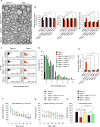RIPK1 mediates axonal degeneration by promoting inflammation and necroptosis in ALS
- PMID: 27493188
- PMCID: PMC5444917
- DOI: 10.1126/science.aaf6803
RIPK1 mediates axonal degeneration by promoting inflammation and necroptosis in ALS
Abstract
Mutations in the optineurin (OPTN) gene have been implicated in both familial and sporadic amyotrophic lateral sclerosis (ALS). However, the role of this protein in the central nervous system (CNS) and how it may contribute to ALS pathology are unclear. Here, we found that optineurin actively suppressed receptor-interacting kinase 1 (RIPK1)-dependent signaling by regulating its turnover. Loss of OPTN led to progressive dysmyelination and axonal degeneration through engagement of necroptotic machinery in the CNS, including RIPK1, RIPK3, and mixed lineage kinase domain-like protein (MLKL). Furthermore, RIPK1- and RIPK3-mediated axonal pathology was commonly observed in SOD1(G93A) transgenic mice and pathological samples from human ALS patients. Thus, RIPK1 and RIPK3 play a critical role in mediating progressive axonal degeneration. Furthermore, inhibiting RIPK1 kinase may provide an axonal protective strategy for the treatment of ALS and other human degenerative diseases characterized by axonal degeneration.
Copyright © 2016, American Association for the Advancement of Science.
Figures




Comment in
-
Axonal Degeneration: RIPK1 Multitasking in ALS.Curr Biol. 2016 Oct 24;26(20):R932-R934. doi: 10.1016/j.cub.2016.08.052. Curr Biol. 2016. PMID: 27780064
References
-
- Beeldman E, et al. A Dutch family with autosomal recessively inherited lower motor neuron predominant motor neuron disease due to optineurin mutations. Amyotroph Lateral Scler Frontotemporal Degener. 2015;16:410–411. - PubMed
-
- Maruyama H, et al. Mutations of optineurin in amyotrophic lateral sclerosis. Nature. 2010;465:223–226. - PubMed
-
- Zhu G, et al. Optineurin negatively regulates TNFalpha- induced NF-kappaB activation by competing with NEMO for ubiquitinated RIP. Curr Biol. 2007;17:1438–1443. - PubMed
Publication types
MeSH terms
Substances
Grants and funding
LinkOut - more resources
Full Text Sources
Other Literature Sources
Medical
Molecular Biology Databases
Miscellaneous

